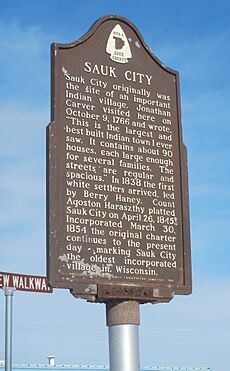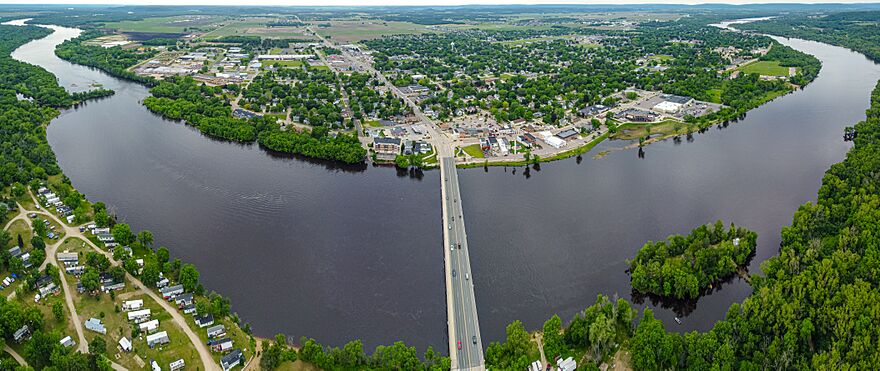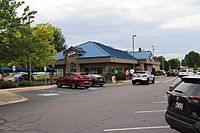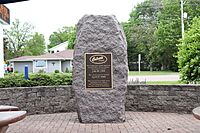Sauk City, Wisconsin facts for kids
Quick facts for kids
Sauk City, Wisconsin
|
|
|---|---|
|
Village
|
|
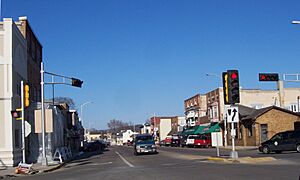
Downtown Sauk City
|
|
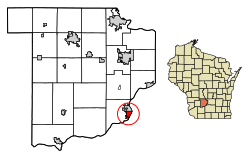
Location of Sauk City in Sauk County, Wisconsin.
|
|
| Country | |
| State | |
| County | Sauk |
| Area | |
| • Total | 1.76 sq mi (4.57 km2) |
| • Land | 1.54 sq mi (3.99 km2) |
| • Water | 0.22 sq mi (0.58 km2) |
| Elevation | 741 ft (226 m) |
| Population
(2020)
|
|
| • Total | 3,518 |
| • Density | 2,261.52/sq mi (873.22/km2) |
| Time zone | UTC-6 (Central (CST)) |
| • Summer (DST) | UTC-5 (CDT) |
| Area code(s) | 608 |
| FIPS code | 55-71650 |
| GNIS feature ID | 1573732 |
| Website | http://www.saukcity.net |
Sauk City is a small village in Sauk County, Wisconsin, United States. It is located right next to the Wisconsin River. In 2020, about 3,518 people lived there. Sauk City was the very first village in Wisconsin to be officially recognized. It was started in the 1840s by Agoston Haraszthy and his business partner, Robert Bryant.
Contents
History of Sauk City
How Sauk City Began
In 1840, a Hungarian man named Agoston Haraszthy was very impressed by the beautiful views along the Wisconsin River. He bought a small piece of land there. Later, he and his business partner, Robert Bryant, bought more land. They founded a town and first called it Széptáj, which means "beautiful place" in Hungarian.
Changing Names and Becoming a Village
In 1849, the town's name was changed to Westfield. Just three years later, in 1852, it changed again to its current name, Sauk City. In 1854, Sauk City officially became a village. This makes it the oldest officially recognized village in the entire state of Wisconsin!
The Free Congregation
In 1852, German immigrants in Sauk City started a group called the Sauk City Free Congregation (Freie Gemeinde). This was a liberal religious group that loved to celebrate German music, literature, and culture. They met in a private home for many years. In 1884, they built Park Hall as their meeting place. Today, this building is home to the Sauk County Free Congregation, which is a Unitarian Universalist fellowship.
"America's Foremost City"
In 1914, a magazine called Harper's Weekly wrote an article that called Sauk City "America's Foremost City." The article talked about a big event where 4,000 people watched a play about the village's history. After the play, the school principal was named the "Civic Secretary." His job was to make the school the main center of town life. They even moved the ballot box from the town hall to the school!
Great Sauk State Trail
In 2017, the Great Sauk State Trail opened. This trail was built on an old railroad line that ran through Sauk City. It's a great place for walking, biking, and enjoying nature.
Geography of Sauk City
Sauk City is located at 43°16′27″N 89°43′42″W / 43.27417°N 89.72833°W. It is on U.S. Route 12, which is a major road. The village is about 18 miles (29 km) northwest of Madison.
The village covers a total area of about 1.76 square miles (4.57 square kilometers). Most of this area is land, with a small part being water.
Population of Sauk City
| Historical population | |||
|---|---|---|---|
| Census | Pop. | %± | |
| 1880 | 917 | — | |
| 1890 | 876 | −4.5% | |
| 1900 | 810 | −7.5% | |
| 1910 | 867 | 7.0% | |
| 1920 | 1,162 | 34.0% | |
| 1930 | 1,137 | −2.2% | |
| 1940 | 1,325 | 16.5% | |
| 1950 | 1,755 | 32.5% | |
| 1960 | 2,095 | 19.4% | |
| 1970 | 2,385 | 13.8% | |
| 1980 | 2,703 | 13.3% | |
| 1990 | 3,019 | 11.7% | |
| 2000 | 3,109 | 3.0% | |
| 2010 | 3,410 | 9.7% | |
| 2020 | 3,518 | 3.2% | |
| U.S. Decennial Census | |||
What the Census Shows
The United States Census Bureau collects information about people living in different places. Here's what they found for Sauk City:
- In 2020, the population was 3,518 people.
- Most people in Sauk City are White (89.3%).
- There are also people from other backgrounds, including Black or African American, Asian, Native American, and people of two or more races.
- About 6.2% of the population is Hispanic or Latino.
In 2010, there were 3,410 people living in Sauk City.
- About 31.7% of homes had children under 18 living there.
- The average age of people in the village was 39.3 years old.
- About 23.8% of residents were under 18 years old.
Economy and Businesses
Sauk City is home to some interesting businesses and companies.
Culver's Restaurant
The very first Culver's restaurant opened in Sauk City on July 18, 1984. Culver's is a popular restaurant chain known for its ButterBurgers and frozen custard. The main office for Culver's is in the nearby town of Prairie du Sac.
Arkham House Publishing
In 1939, a publishing company called Arkham House was started in Sauk City. It was founded by August Derleth and Donald Wandrei. This company is special because it focuses on publishing books by H. P. Lovecraft and other writers of dark fantasy stories. Arkham House is still located in Sauk City today.
Cuca Records
Cuca Records was a record company founded by James Kirchstein in 1959. It was located on Water Street, next to his father's grocery store. Cuca Records made many different types of music records until the early 1970s, including polka, folk, and jazz music.
Jacob Leinenkugel
Jacob Leinenkugel was born and grew up in Sauk City. He is known for starting the Jacob Leinenkugel Brewing Company, a famous brewery.
Important Buildings and Structures
- Cuca Records
- Freethinkers' Hall
- Lachmund Family House
Education in Sauk City
Students from Sauk City attend Sauk Prairie High School. This school is located in the neighboring village of Prairie du Sac. The school's mascot is the eagle. This mascot was chosen because many eagles live along the Wisconsin River, which is near Sauk Prairie.
Notable People from Sauk City
Many interesting people have come from Sauk City, including:
- August Derleth, a famous author and publisher.
- Agoston Haraszthy, who helped found Sauk City and was a pioneer in winemaking.
- Greg Jensen, a former professional football player in the NFL.
- Robert J. Keller, who served as a state representative in Wisconsin.
- Cyrus Leland, an attorney and state assemblyman.
- Emanuel L. Philipp, who was a former Governor of Wisconsin.
- John B. Quimby, a former Wisconsin State Senator.
- Mark Schorer, an author and professor.
- Scott Schutt, another former professional football player in the NFL.
See also
 In Spanish: Sauk City para niños
In Spanish: Sauk City para niños


